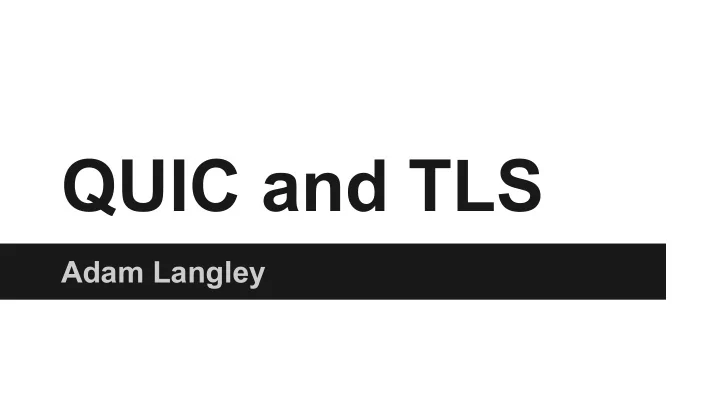

QUIC and TLS Adam Langley
History ● The initial ideas for SPDY involved it being a UDP protocol. ● That was dropped to limit the scope. ● SPDY worked out OK and QUIC continues it by replacing TCP and TLS under SPDY/HTTP 2.
History (2) ● QUIC is primarily a Transport experiment, but security isn’t optional any more. ● In 2013 I designed and implemented QUIC Crypto, a 0-RTT capable security layer for QUIC.
QUIC State Machine.
(TLS State Machine)
QUIC Crypto in a slide. ● Server signs a config block, containing Diffie-Hellman parameters, supported ciphersuites etc. ● If the client knows nothing, it prompts for the config block. ● Otherwise, it calculates shared keys and starts talking.
QUIC Crypto upshots. ● 0-RTT ● No resumption ● Fast (curve25519, no online signatures). ● Forward secure to TLS’s level or better.
QUIC Crypto references ● Spec ● “How Se-cure and Quick is QUIC? Prov-able Se-cu-rity and Per-for-mance Analy-ses”, Ly-chev et al, to ap-pear in IEEE Se-cu-rity & Pri-vacy 2015 ● “Multi-Stage Key Ex-change and the Case of Google’s QUIC Pro-to-col”, Fis-chlin and Günther, ACM CCS 2014.
QUIC Crypto and TLS 1.3 ● TLS 1.3 looks quite a lot like QUIC Crypto at the moment, which is no accident. ● TLS 1.3 has rejected offline signing. ● QUIC’s anti-replay didn’t work and nobody noticed until a couple of weeks ago.
QUIC and TLS 1.3 ● QUIC is a UDP based protocol so worries about spoofed source addresses, like DTLS. ● But QUIC provides ordering and reliability to the crypto handshake, so that’s more like TLS. ● The crypto part of QUIC can be separated from the transport parts.
Recommend
More recommend